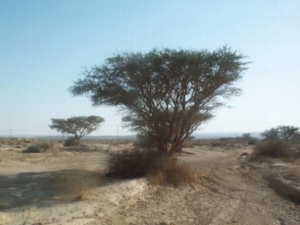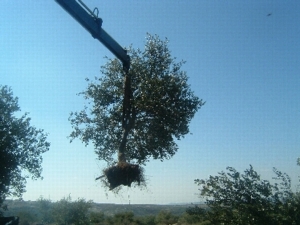And you shall reduce, reuse, and recycle with all your heart, with all your soul, and with all of your resources. And concern for the planet that I command you today shall be upon your hearts. And you shall teach sustainability to your children and speak of it frequently: when you sit in your energy star rated home, or when you ride your bike to work, when you go to sleep and when you wake up. And you shall have a non-disposable mug as a sign on your hand and an organic cotton hat to shade your eyes.
If you were to open the freezer of my South Jerusalem apartment you would find it filled with the organic "waste" that quickly accumulates in my vegetarian kosher kitchen. Every few weeks, my roommate and I load the compost cubes into our backpacks for the two kilometer trek to the community compost heap. My interest in vegetarianism and my compost pilgrimages are expressions  of my values as a Jewish environmentalist. By composting my food scraps, the nutrients that would otherwise accumulate in an un-holy land-fill are remade into rich hummus that will contribute to the Earth’s beauty. My mostly vegetarian diet is not a protest against animal cruelty (though it probably should be) but is inspired by the logic that eating nearer to the bottom of the food chain is a better use of Earth’s resources—that it is more sustainable.
of my values as a Jewish environmentalist. By composting my food scraps, the nutrients that would otherwise accumulate in an un-holy land-fill are remade into rich hummus that will contribute to the Earth’s beauty. My mostly vegetarian diet is not a protest against animal cruelty (though it probably should be) but is inspired by the logic that eating nearer to the bottom of the food chain is a better use of Earth’s resources—that it is more sustainable.
This piece looks at what it means to be a Jewish Environmentalist and what challenges come about when attempting to understand such an identity. This is quite challenging as the terms Jewish and environmentalism mean many different things to many different people. Thus, this essay is inherently personal. Nevertheless, I hope that my ideas have value for others.
On a most basic level, environmentalism is the view that modern industrial society is seriously detrimental to Earth’s life support systems and that humankind has a responsibility to restore and protect the capacity of our planet to sustain life. Those who take this responsibility seriously are environmentalists.
The notion that industrial consumer society is bought at a severe ecological cost became in the United States with the publication of Rachel Carson’s Silent Spring in 1962. The book’s publication along with other dramatic events such as the Cuyahoga River Fire of 1969 created widespread awareness that modern industrial society was seriously detrimental to plant, animal, and human life. These events ultimately led to the passage of the National Environmental Policy Act in 1969, the Clear Air Act in 1970, and the Endangered Species Act in 1973 as well as the creation of organizations such  as Environmental Defense in 1967 and Greenpeace in 1971. These efforts represent the beginning of the contemporary environmental movement that continues to exist today.
as Environmental Defense in 1967 and Greenpeace in 1971. These efforts represent the beginning of the contemporary environmental movement that continues to exist today.
However, strictly focusing on the utility of environmental problems and their solutions ignores the many layers of culture that both encourage and deter environmental action. These layers of culture are the topic of the rest of this essay and is the lens through which I choose to understand Jewish environmentalism. In this light, Jewish environmentalism is the religious significance Jews have assigned to their involvement in activism in response to ecological issues. For Jews, this meant finding support for their activism in classical Jewish texts.
Ecologically Concerned Jews didn’t need to look very far. Classical Jewish sources contain an abundance of legal and literary texts that address the relationship between God, Creation, and humanity. In fact, the Bible begins with the Creation narrative that contains the imperative of L’ovdah U’leshomra “to till and to guard” the Earth. Jewish Environmentalists point to this along with many other texts to assert the existence of an ecological meta-ethic that demands that we care for the Earth.
Thus, as a movement, Jewish environmentalism is not only a collection of Jews who care about the environment but Jews who understand their actions as physical expressions of basic Jewish texts. Today, there are more than twenty regional and national Jewish environmental organizations and this position is becoming a mainstream. The widespread acceptance of this position is affirmed by the resolution recently passed by the Rabbinical Council of America, the rabbinical arm of Centrist Orthodoxy in support of a Torah-based Environmental Movement.
One of the challenges of basing an environmental movement on the Creation narrative is the assumption that nature was created as we experience it and that humanity is the pinnacle of that Creation. At worst, this means that humankind has an obligation to control and subdue nature. This message is equally clear from the Creation narrative but is ignored, deemphasized, or reinterpreted by Jewish environmentalists. At best, this theological position presents a static, non-evolving, natural world that humanity has a responsibility to preserve. In other words, the Creation narrative assumes a binary and unequal relationship between nature and humanity. The question then becomes, do we dominate and change nature or do we preserve nature.
The theological component of Jewish environmentalism is augmented by Biblical laws that reflect the concerns of contemporary environmentalists. Two particular laws that deal with our relationship to the natural world are the prohibition against hybrid planting, kilayim, and the law of Shiluach Haken that commands that one shoo away the mother bird before taking of her  young. For Nachmonides, a 13th century Spanish scholar, the prohibition of kilayim is based on the notion that the world as Created by God must remain in its original state. Nachmonides assumes that the wheat, olive, and grape species familiar to us and to our biblical ancestors are those that were created directly by God and must remain in their original form. Any human induced change would be an affront to God.
young. For Nachmonides, a 13th century Spanish scholar, the prohibition of kilayim is based on the notion that the world as Created by God must remain in its original state. Nachmonides assumes that the wheat, olive, and grape species familiar to us and to our biblical ancestors are those that were created directly by God and must remain in their original form. Any human induced change would be an affront to God.
Similarly, Nachmonides’ explanation of Shiluach Haken is that it is a measure against species extinction. The extinction of a species would represent a fundamental altering of Creation and for Nachmonides this is theologically abhorrent. Jewish environmentalists advance these texts in their efforts to fight GMO (genetically modified organisms) and to fight against species loss. Using these texts to speak about contemporary environmental issues is not so straightforward as these laws are based on a faulty understanding of the relationship between Humanity and other species. These texts assert a false dichotomy that puts nature and humanity in opposition to one another. Far from being a minor point, I believe that this misunderstanding is central to understanding why people are often reluctant to accept environmentalism.
Despite the development of evolutionary thinking that clearly shows that humanity and nature develop together, viewing nature and humanity in binary terms remains quite popular. In market terminology this concept is expressed as the struggle between the “environment” and the “economy.” We must choose: either we act in the interests of the economy or we act in the interest of the environment. The falseness of this position is easily exposed. The goods, services, and energy available to us through the wonders of market capitalism are all extracted from the lithosphere, hydrosphere, or atmosphere that is often titled Creation.
The perceived opposition of humanity and environment is not only inaccurate but is also the basis for a primary challenge to environmentalism—that environmentalists care about nature at the expense of humanity. This position made itself apparent to me through a small ethnographic experiment that I conducted while teaching a class on Judaism and the environment to teenagers from a Yeshiva high-school. Upon introducing the topic, I immediately heard students declare dismissively, “tree-hugger.” Surprised at their antagonism, I invited each student to share the first thing that came to mind when they heard the word “tree-hugger.” What I found was that for these teenagers, "tree hugger" stood in opposition to “people hugger.” In other words, environmentalists care about plants and animals at the expense of caring for people. This would be a good argument if human and ecological interests were actually in opposition to one another. The unity of life contradicts their claim.
Despite the widespread use of the moniker “tree hugger,” few know of the phrase’s origin in the Chipko movement. The Chipko movement was a grassroots effort by indigenous people to curb unsustainable forestry practices in the Uttar Pradesh in the Himalayas. The movement’s name Chipko literally means “embrace” and refers to the method in which trees were saved from the chain saw. The philosophy behind the Chipko movement emphasized the unity of  all life, breaking down the dichotomy between Humanity and nature. In fact, one of its more prominent members, Sunderlal Bahuguna coined the slogan “ecology is permanent economy” an explicit attacking the perceived binary between ecology and capital. With this historical precedent in mind, the contemporary use of “Tree hugger” becomes highly ironic.
all life, breaking down the dichotomy between Humanity and nature. In fact, one of its more prominent members, Sunderlal Bahuguna coined the slogan “ecology is permanent economy” an explicit attacking the perceived binary between ecology and capital. With this historical precedent in mind, the contemporary use of “Tree hugger” becomes highly ironic.
The problem with a binary approach towards environmentalism is not only tactical. If nature and people are truly in opposition then by definition we cannot stop destroying nature we can only destroy nature at a slower pace. An approach that understands the interconnectedness of all Creation including humankind would allow human society to work for the benefit of itself and of the environment of which it is an integral component. What needs to be understood is that environmental activism and humanitarian causes are not in opposition to one another. Rather, the co-dependence of the environment and humanity means that humanitarianism and environmentalism are intrinsically connected to one another. Humanism and environmentalism are cut of the same cloth.
With these considerations, what might it mean to be a Jewish environmentalist? One could claim that questioning the Jewish environmental narrative is bad public policy or that it interferes with the important work that is being done by Jewish environmentalists. On the contrary, connecting humanitarian and ecological suffering makes the Jewish connection even stronger. Jewish environmentalists can combine their responsibility towards nature with the even more established Jewish responsibility towards the “Orphan, Widow, and Stranger.”
Further, we should look towards Jewish texts not to create an ecological Halakha or law but to inspire us to embody the sensitivity and awareness to realize our interconnectedness and co-dependence on the natural world. Saying blessings before every bite of food or sip of water is a practice that can help embody these values. Similarly, understanding Shabbat as a day to acknowledge our ultimate dependence on Creation and the reemphasis of the agricultural basis for the pilgrimage holidays can also help develop such an ethic.
I close this article with a rereading of a classic Jewish environmental text in light of what I have written. Baal Tashchit, the Biblical prohibition against wasting is often cited as an ecological Halakha. This law is explained by the Sefer Hachinuch, a medieval work that enumerates and explains the 613 Biblical commandments:
The basic principle behind this mitzvah [Bal Tashchit] is to teach us to love that which is good and worthwhile and to cling to it, so that good becomes a part of us and we will avoid all that is evil and destructive. This is the way of the righteous and those who improve society, who love peace and rejoice in the good in people and bring them close to Torah: that nothing, not even a grain of mustard, should be lost to the world, that they should regret any loss or destruction that they see, and if possible they will prevent any destruction that they can. Not so are the wicked, who are like demons, who rejoice in the destruction of the world, and they are destroying themselves.
This text is often taught by Jewish environmentalists as the basis for our Biblical obligation to recycle and to avoid disposables. This text is not about recycling or avoiding disposables as many Jewish environmentalists claim; rather, this text is about the cultivation of religious personalities that are sensitive to life and are fully aware of the consequences of their actions. The Sefer Hachinuch looks to those who save a grain of mustard as indication of who is good for society. For me, this is a Jewish environmental text that is compelling. It is an environmentalism that is not only about solving ecological problems but about creating a just society. It is about creating a world where, as the Chipko say, ecology is permanent economy.








This web-site may be a walk-through like the info you wished about it and didn’t know who ought to. Glimpse here, and you’ll undoubtedly discover it.
What I wouldnt give to have a debate with you about this. You just say so many things that come from nowhere that Im fairly positive Id have a fair shot. Your blog is terrific visually, I mean people wont be bored. But others who can see past the videos and the layout wont be so impressed with your generic understanding of this subject.